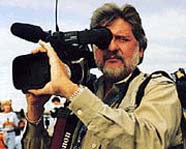|
|
Letter
from |
Welcome
to the SEPTEMBER 2001 edition of The Digital Journalist.
We are starting a two-part
series with this month's issue of "The State of Photojournalism."
In last month's issue our editorial discussed "The Reality of our
Recession." There is no doubt whatsoever that photojournalism, whether
in newspapers, magazines, picture agencies, television or the web, is
undergoing a profound and, to many, disturbing transformation. The winds
of corporate and technological change have created a vortex in which even
the most basic values and standards have been thrown into question. This
month we will focus on newspapers and broadcast television news. Next
month we will look at magazines and the web. We are doing our best to
approach these subjects with an open and inquiring mind.
Because there is such an air of gloom and doom surrounding the industry
at this point, we wanted to start off the series with some good news.
We wanted to find someplace where all the elements-motivation of photographers,
inspired editors, and most important the full financial support of publishers-came
together to create a yardstick by which photojournalism could be judged.
These days, when you see something done well, it stands out with crystalline
clarity.
We found such a place at the Star Ledger in Newark, New Jersey. After
outsourcing their photography for more than 30 years, and faced with the
task of creating their first photo department, they decided to enlist
the best advice of experts on how to create a photo department for the
21st century. Their goal was to win a Pulitzer in three years. They did
it in one.
We spent two days at the Star Ledger in mid-August and, to say the least,
it was an energizing experience. We interviewed Editor Jim Willse, Director
of Photography Pim VanHemmen, and went on assignment with Pulitzer Prize-winning
photographer Matt Rainey. We are proud to present a portfolio of the best
of the Star Ledger's work from the past year. You'll find text as well
as streaming video interviews with Jim Willse and interview clips from
Van Hemmen and Rainey. There is also a RealVideo clip included of the
moment that the Star Ledger staff learned of their victory in the Pulitzers.
You may want to have a hankie ready.
From the Star Ledger, we move on to The New York Times, which has found
itself at the center of controversy in the past several months over freelance
photographers' contracts. We had a frank discussion with Director of Photography
Margaret O'Conner who oversees more than a 1,000 published pictures a
week, more than any other publication, about how she views the profession
from her office on West 43rd Street. We run her interview both in text
and streaming video. We also run a portfolio of her favorite pictures
taken by Times photographers
over the past year.
A special word of thanks to Susan Markisz who reported and wrote both
our Star Ledger and New York Times packages, and to our Executive Producer
David Snider who spent many long hours editing the streaming videos that
accompany these features.
After a career culminating as Chief Photographer for the San Merced Sun
Star, Gregg Hubbard left the California paper last month to move on to
academia. He offers us a look at the changes he experienced as the newspaper
he worked for underwent a transformation that many newspapers are facing
today.
Mark Herzberg, Director of Photography of the Racine, Wisconsin Journal
Times, muses over the overload of too many pictures flooding editors'
desks.
Contributing Editor Peter Howe reports on the new photo show in New York,
"M.I.L.K.," and considers the differences between it and the
famous "Family of Man" exhibition.
As we move to looking at what is going on in television news, our Videosmith,
Steven Trent Smith, looks back over his 30 years as a top network magazine
show cameraman, and reports on how the financial pressures have caused
the same kind of havoc in his industry that still photojournalists now
face in "There's No Business Like News Business."
Broadcast Professional Editor and Publisher Mark Bell gets down to real
issues as he worries about the direction - or even sustainability - of
television photojournalism in his article "The Crisis in Broadcast
Television."
To give us a break from all this heavy soul-searching, our irascible Jim
Colburn offers us "Postcards from Waco."
Amy Bowers muses over expense receipts, and Bill Pierce wonders if "
It's not News, maybe it's Art."
Our "Radio Roger" Williams is welcomed back to our columns with
his report on wireless internet systems.
In our Camera Corner, we take an in-depth look at the new Canon XL1S camcorder.
We think this issue will give you a lot to think about and, hopefully,
discuss in the month ahead. In October, we take "The State of Photojournalism"
to look at magazines and the web.
We hope to see you back then.
Before I end this publetter, as we start our fifth year online, I would like to thank all the contributors who have continued to help us put out The Digital Journalist every month. Our columnists, Jim Colburn, Amy Bowers, Bill Pierce,Roger Williams, Fritz Nordengren, Steve and Martha Smith, our Contributing Editors, Peter Howe, David Friend, Marianne Fulton, Garrett White, Grazia Neri, and Horst Faas; Our Assignment Sheet editor Dick Kraus; Our Copy Editor Joan Gramatte, Our Administrative Assistant Marie Williams who somehow manages to get some money in the bank, and finally our Webmaster and Executive Producer, David Snider, who is the guy who actually puts this publication together. Lastly, we would not even be here without the continued support of Hewlett Packard, who provides our server, and our special angel, James Rigger.
Thanks to all of you.
Dirck Halstead
